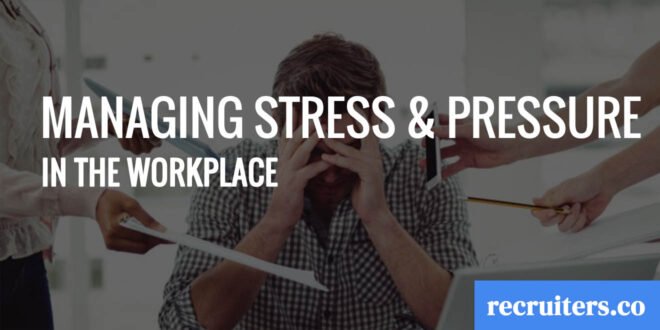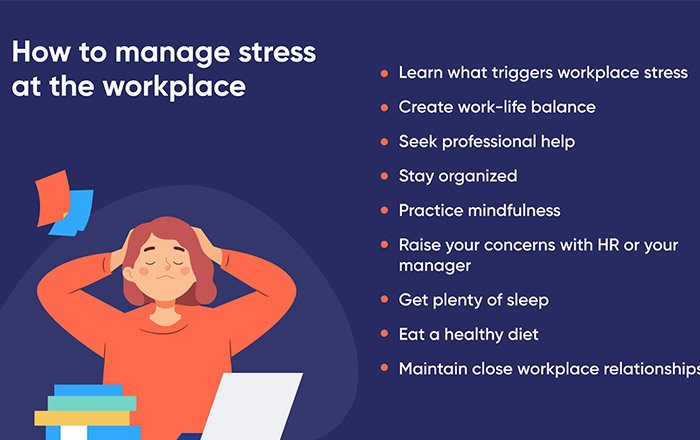Managing Stress and Pressure in the Workplace

Working in a professional environment comes with increased pressure to perform, creating additional stress–two important factors that can affect an individual’s and their team’s productivity, morale, and resilience.
Stress and pressure are commonly confused as the same force when each is actually a distinct force on its own; therefore, learning to understand and recognize these concepts is key so methods of address can be crafted or implemented from various angles dealing with personal skill development techniques to changes at whole workplace level.
This outline aims to explore the world of stress and pressure in electronic below by giving strategies and resources for employees, managers, and others alike.
Stress and Pressure

Causes, symptoms, and impact on productivity
Stress is an intangible response to perceived or imagined pressure and danger. It is caused by physiologic factors like hormones released in reaction to events related to career, health, and relationships. Its symptoms range from difficulty concentrating and eating problems to physical tension and fatigue.
Left unmanaged it can affect both emotional balance as well as productivity in different areas of life such as workplace efficiency, task effectiveness also academic success. Knowing a person’s sources of stress and symptoms helps them recognize issues faster and adhere prepared plan of approach to working through them.
Differentiating between stress and pressure: Understanding their sources and effects
Stress is a pervasive and often hidden problem in many workplaces. It can include things like feeling overwhelmed, time pressure, job insecurity, or difficulty managing conflict. The physical symptoms of stress translate into decreased energy levels, disturbed sleep patterns, and muscle tension headaches.
Stress can impact overall productivity by leading to fatigue and burnout when it is not addressed effectively. Differentiating stress from pressure is important because only one involves the actual strain of having too much coming at you- the other encompasses functionality while under the manufactured accumulation of demands or expectations.
Pressure, while uncomfortable, is necessary for a driving goal without some stress a person cannot elicit potential productivity from motivation and can become stagnant in completing involved tasks.
Recognizing the signs of excessive stress and pressure
Recognizing the signs of excessive stress and pressure is important. It can cause physical and psychological issues that affect personal, family, and professional life.
Signs include fatigue, insomnia, low productivity levels or work quality, irritability or anger outbursts, headaches or muscular tenseness, loss of appetite/overeating, and difficulty concentrating and making decisions.
If any of these physical or mental stress markers become regular occurrences then it’s best to examine what underlying sources may be fueling the overload pressures and take time to rest.
How to Manage Stress and Pressure
1. Building a Resilient Mindset

Developing self-awareness
Developing self-awareness is an essential part of building resilience and managing stress and pressure at work. Becoming aware of personal triggers allows us to identify the factors that lead to stressful or pressured situations, such as thinking in black & white terms or working without breaks.
Recognizing the mental processes—having a reduced attention span, and dropping productivity post deadlines—empowers us with insight into what can cause unwanted feelings. Being attentive to subtle signals helps guide prepared notions and reactions freeing our minds from stagnation for further progress.
Adopting a positive mindset
Adopting a positive mindset is an incredibly beneficial strategy for managing stress and pressure at work.
To cultivate optimism, one must challenge negative thinking and cast doubts to one side. It may also be useful to actively search for something to appreciate even on challenging days – whether it’s focusing on personal strengths or simply giving thanks.
Practicing self-compassion
Practicing self-compassion is an essential tool for managing and overcoming stress and pressure in the workplace.
Self-kindness requires acceptance of personal weaknesses while recognizing human worth. This might involve voicing positive affirmations instead of engaging in negative self-talk or reclaiming a sense of empathy.
One should counterbalance indulgence with accountability and provide themselves with emotional support, allowing errors to be renounced as learning steps during his/her journey toward growth so that they keep motivation to press even harder leading up to the desired outcomes. All these, if taken with measure help elevate willpower rather than invalidate one’s integrity through impossible-to-perfect standards.
Fostering a growth mindset
Fostering a growth mindset is key to effectively managing stress and pressure in the workplace. Taking on a learning attitude can help individuals cope with difficult environments that bring up feelings of doubt and imposter syndrome.
Coping resilience plays an important role here – self-resilience speaks for recognizing mistakes, welcoming constructive criticism from colleagues or supervisors, and turning weaknesses into motivators which can–in turn translate into personal and professional strength during challenging times.
At the end of the day placing importance on adaptive problem solving, taking risks, seeking opportunities, and actively persisting contributes immensely to alleviating any difficult environment.
2. Effective time management

Effective time management techniques such as planning, prioritizing, and delegating tasks can be incredibly helpful in reducing stress and pressure in the workplace. When starting any new project or task, it is important to break it down into achievable goals and milestones that can be effectively managed.
Prioritizing tasks by significance and employing division of labor (if applicable) can also help ensure that the done most effective manner. Delegation should not only ensure important tasks are taken care of but also allow employees to relearn and develop new skills.
Ultimately, these techniques applied together provide the ability to confidently complete deadlines effectively while reducing stress and pressure associated with looming task deadlines.
3. Developing Effective Coping Mechanisms

Seeking social support
Developing strong relationships at work positively impacts our emotional well-being and lessens the impact of stress and pressure. Open communication is essential for building close connections with colleagues, team members, and supervisors alike. Being transparent about personal needs, limitations, triggers and experiences in general can reduce feelings of stress or anxiety.
Seeking support from peers can be complemented by professional accountability partners which also allow for candid conversations to motivate working methods or create strategies to enhance performance.
Utilizing humor and laughter:
Humor and laughter can be powerful tools to effectively cope with stress and pressure in the workplace. Studies have shown that humor and leisure activities, such as telling jokes or stories, encourage endorphins release which helps reduce strain on the body and provide relief from worries associated with work.
Utilizing humor can also create a more positive environment by helping colleagues develop stronger relationships with one another while lightening up difficult conversations.
4. Effective Communication and Boundaries

Setting boundaries
It is important to develop an effective communication style and set clear boundaries in order to successfully manage stress and pressure at work. Setting boundaries involves knowing when it is suitable to say “no” while recognizing what your workload allows for.
This includes both external factors, such as turning down requests from colleagues, and internal aspects like giving yourself permission to have a break away from work.
Applying conflict resolution techniques
Setting boundaries is an important part of managing stress and pressure in the workplace. This involves knowing when to say “no” to a task or taking extra time for self-care, as well as establishing and maintaining a work-life balance.
In addition, avoiding conflicts can help reduce levels of stress and pressure that arise from working with colleagues and within a team environment. Applying conflict resolution techniques such as open communication, active listening, compromise, and keeping emotions in check enables individuals to resolve disputes quickly and amicably.
Conclusion
In conclusion, it is essential to learn and implement strategies to manage the stress and pressure of the workplace environment. Stress plays an inevitable role in our lives but needs not to be a hindrance and can prove one’s motivation with effective management techniques.
Managing stress at work requires proper time management, safe boundaries, communication skills, assertiveness, self-awareness, and resilience.
Reading to engage our recruiting agency for your next hire? Get in touch today!
- Mastering Internal Mobility: A Comprehensive Guide to Success - August 10, 2023
- Effective Recruiting Strategies in a Competitive Sales Labor Market - July 27, 2023
- 6 Essential Factors to Attract Top Talent - July 19, 2023
